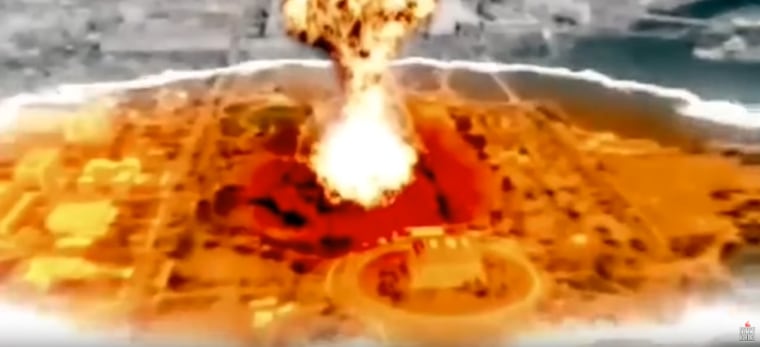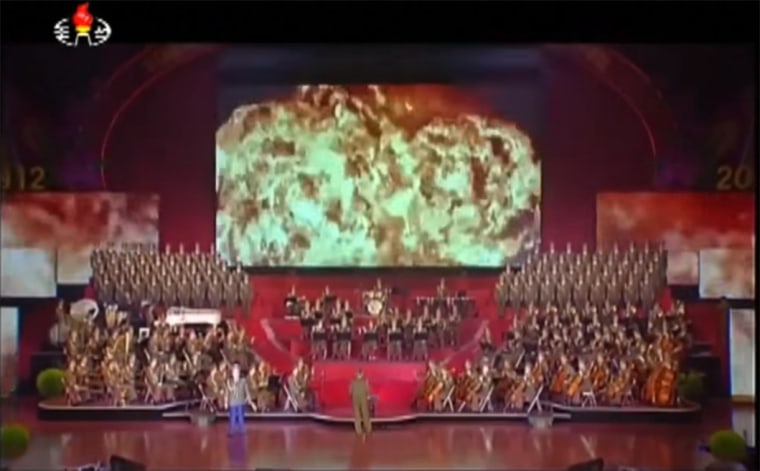There isn’t much North Korean media, but what little exists is full of images of nuclear destruction — of U.S. cities incinerated by North Korean nukes. News anchors promise that a coming conflict will leave Washington in "a sea of fire." A Communist party website warned Tuesday that Pyongyang is "waiting for the moment it will reduce the whole of the U.S. mainland to ruins."
North Korean propaganda has gotten so over-the-top that after that last headline, the Chinese urged the Koreans to pipe down. The Chinese Foreign Ministry suggested both the North and the U.S. should "remain calm and exercise restraint, stop irritating each other," which experts said was directed more at Pyongyang than D.C.
Related: North Korea Speeds Up Missile Tests To Send Message to Trump
It all sounds very ominous, but is it? While the tempo of anti-U.S. rhetoric is higher than in past years, there hasn’t been that much of a change in its content. As one U.S. intelligence official noted, there’s always been "hyperbole and propaganda in their messaging."
In fact, say experts and U.S. officials, most of the rhetoric so widely replayed in Western media is not meant for the world stage but for internal consumption in the "hermit kingdom."
U.S. officials argue the content of the propaganda is intended to sustain the central ideology of the North Korean state, that only the "benevolence and wisdom of the Kim family" stands between the North’s populace and the abyss. An aggressive stance towards the U.S. enhances that belief system. It shows the leadership will not back down, said one U.S. official.
Related: North Korea Test Fire of Ballistic Missile Fails
Still, at least one expert on North Korean propaganda said that while a lot of Pyongyang’s rhetorical flourishes are "eminently mockable," they shouldn’t be ignored.
"Their bluster now carries more weight," said Sung-Yoon Lee, the Kim Koo Korea Foundation Professor in Korean Studies at the Fletcher School. "We can patronize them, but when their ability to carry out such attacks gets close, when they show the technology, I think their threats become more credible."

Lee also said that outsiders "should not be reduced to patronizing a regime that is very cruel."
As for the rising tempo of propaganda, Lee and the U.S. intelligence community agree it’s part and parcel of North Korea’s approach to missile launches and nuclear test preparations.
A second U.S. intelligence official said the recent increase in noise is about attention.
"They need it," said the official, noting they weren’t getting it from the Obama administration. "So they’ve been pounding out stuff at a sustained pace for at least a year."
At times, the propaganda seems targeted directly at the presidents of the United States and South Korea. In one video, Lee noted, the White House is obliterated "Independence Day style" — as in the movie where aliens flattened the American capital. In another, a full-scale model of the South Korean presidential compound, the Blue House, is blown apart by North Korean artillery.

And the messaging can get even more personal. Lee points to attacks on President Obama and the recently impeached president of South Korea, Park Geun-hye, in 2015. Obama, he said, was referred to as a "wicked black monkey" who should return to Africa "and feed off bread crumbs thrown by tourists" while Park was called a "dirty old whore." The North, Lee said, received criticism in the international community for its racist and sexist commentary.
Some of the more recent videos directed against the U.S. have high production values, with heavy use of graphics and animations.
In March, North Korean television showed a video of a simulated nuclear missile attack on The Ellipse, just south of the White House. The announcer talks about how "the American imperialists and the South Korean traitors … will face the most absurd and painful self-destruction, digging their own tombs with their bare hands." The video ends with a sea of gravestones superimposed over an American flag.
Related: North Korea Showing Off Missiles That Can't Fly, Say Experts
A month later, as part of the celebration of the Day of the Sun, North Korean TV broadcast a military concert in front of a big screen display showing a missile attack on San Francisco. Kim stands on the dais as the orchestra reaches a crescendo perfectly timed with a simulated nuclear detonation.
One U.S. official said the videos are at once a throwback to earlier Cold War messaging and strangely au courant. He called them "almost post-modern, ironic rather than earnest."
There is a numbing sameness to North Korea’s words and imagery, but the U.S. monitors the messages closely for any changes. As a second U.S. official said, if the Koreans stop talking about turning South Korea into a "sea of fire" and threaten something even more horrific, the intelligence community — and the world — need to take note.
